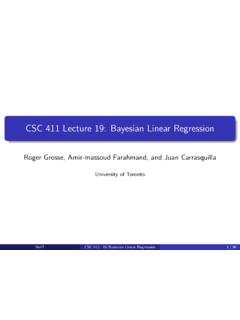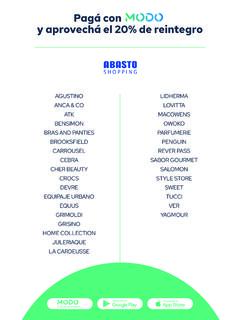Transcription of Virtual Reality: Past, Present, and Future
1 Virtual Reality: Past, Present, and FutureEnrico Gobbetti and Riccardo Scateni CRS4 Center for Advanced Studies, Researchand Development in SardiniaCagliari, Italy AbstractThis report provides a short survey of the field of Virtual reality, high-lighting application domains, technological requirements, and currently avail-able solutions. The report is organized as follows: section 1 presents thebackground and motivation of Virtual environment research and identifiestypical application domains, section 2 discusses the characteristics a virtualreality system must have in order to exploit the perceptual and spatial skillsof users, section 3 surveys current input/output devices for Virtual reality,section 4 surveys current software approaches to support the creation of vir-tual reality systems, and section 5 summarizes the Background and MotivationVirtual reality (VR) is not a new concept. The origins of VR can be tracedas far back at least as The Ultimate Display [85], a seminal paper by IvanSutherland that introduced the key concepts of immersion in a simulatedworld, and of complete sensory input and output, which are the basis ofcurrent Virtual reality research.
2 The following challenge was set: CRS4, Via N. Sauro 10, 09123 Cagliari, Italy, screen is a window through which one sees a Virtual challenge is to make that world look real, act real, soundreal, feel real [85].Sutherland s challenge, which can be summarized as offering presencesimulation to users as an interface metaphor to a synthesized world, hasbecome the research agenda for a growing community of researchers andindustries. The motivation for such a research direction is twofold. From anevolutionary perspective, Virtual reality is seen as a way to overcome limita-tions of standard human-computer interfaces; from a revolutionary perspec-tive, Virtual reality technology opens the door to new types of applicationsthat exploit the possibilities offered by presence Evolutionary Perspective: Better User InterfacesThe last decades have been marked by the development of the computeras a tool in almost every domain of human activity.
3 One of the reasonsfor such a development was the introduction of human-friendly interfaceswhich have made computers easy to use and to learn. The most successfuluser-interface paradigm so far has been the Xerox Parc desktop metaphorpopularized among computer users by the Macintosh. Graphical user in-terfaces based on the desktop metaphor can be seen as a limited form ofvirtual environment, that simplifies human-machine interaction by creatinga palpable, concrete illusion for users to manipulate real, physical objectspositioned on a desk , while the desktop metaphor is well suited to interacting withtwo dimensional worlds, it starts to show limitations when interacting withthree dimensional worlds. Major drawbacks of this solution are the lack ofcorrelation between manipulation and effect as well as the high degree ofcognitive separation between users and the models they are editing [21, 33,32]. The inadequacy of user-interfaces based on 2D input devices and 2 Dmindsets becomes particularly evident in applications that require users tospecify complex spatial information, such as 3D modeling and animation,motion control, or surface modeling.
4 In all these cases, the low-bandwidthcommunication between 2D user-interface and application, together with therestrictions in interactive 3D motion specification capabilities of the mouse,make it extremely difficult for the users to perform their work with simpleintuitive actions. The feedback provided to the users is also a problem: thelimited information about the structure of the three-dimensional world thatis conveyed by a fixed visual image often forces the application to rely onmultiple views to provide additional depth information. This requires usersto combine the separate views to form a mental model of complex objects,adding further complexity to this often very difficult task [44] and forcingusers to concentrate on how to obtain what they want instead of the task2itself. It is increasingly evident that new device configurations and userinterface metaphors that enable users to work directly in three dimensionshave to be reality research, starting from the fact that human beings are wellequipped to interact with the world they live in, should strive to make usersinteract with Virtual worlds in the same way they interact with real worlds,thus making the interaction task much more natural and reducing potential of Virtual reality systems as a more intuitive metaphor forhuman-machine interaction is thus enormous, since the user can exploit hisexisting cognitive and motor skills for interacting with the world in a rangeof sensory Revolutionary Perspective: Novel ApplicationsVirtual reality is more than just interacting with 3D worlds.
5 By offeringpresence simulation to users as an interface metaphor, it allows operatorsto perform tasks on remote real worlds, computer generated worlds or anycombination of both. The simulated world does not necessarily have to obeynatural laws of behavior. Such a statement makes nearly every area of hu-man activity a candidate for a Virtual reality application. However, we canidentify some application areas were benefits are more straightforward thanothers. The following is a summary of the most important PrototypingDecisions taken during the design phase of large scale engineering projectsare often the most delicate ones, because of their possibly dramatic effect onfinal results, timings, and costs. Mock-ups are routinely used for applica-tions such as testing equipment integration, accessibility and space require-ments in domains ranging from aerospace and automotive manufacturing toarchitecture. Virtual prototyping allows designers to test and improve theirdesign as when using physical mock-ups, but better, earlier and with moreopportunities for multi-site collaborations [5].
6 Architectural building walkthru have been one of the most successful ap-plications of Virtual reality. These systems, the simplest examples of virtualprototypes, permit the architect to prototype a building and to iterate withhis client on the detailed desiderata for it [14, 3].Natural interaction with digital mock-ups is very important, especiallyfor testing purposes. In an attempt to overcome present CAD systems inter-activity and concurrent design limitations, large engineering projects haveoften been accompanied by the development of various kinds of specializedvirtual prototyping tools [26]. Examples include the ISS VR Demonstratorused by Rolls-Royce to make an assessment of how easy it would be to buildan engine and maintain it [39] and Boeing s high-performance engineeringvisualization system used during the design of the 777 [62]. Moreover, the3 French Space Agency (CNES) and CISI have jointly launched the PROVIS[9] research project in 1995 for developing solutions for satellite designersto create, manipulate, and study their models using digital mock-ups, whileCRS4 and CERN have jointly developed the i3d system for supporting thedesign of CERN s Large Hadron Collider [6, 7, 34, 35].
7 These efforts showthe interest of interactive Virtual prototyping for early testing of , research and development efforts for building Virtual prototyp-ing systems have started independently from the need of a specific research at the Fraunhofer Centre for Research in Computer Graph-ics is studying how to integrate existing tools to provide Virtual prototypingcapabilities to existing CAD systems [48]. Some recent CAD products add-ons such as PTC Pro/Fly-Through, Mechanical Dynamics ADAMS, MatraDatavision s Megavision, Prosolvia Clarus Real-Time Link, and EDS Uni-graphics Modelling module follow the same direction, providing real-timevisualization capabilities for engineering designs. Systems such as Divi-sion s dV/Mock-Up and dV/Reality, only available for PCs and SGI, havestarted to add to high-performance rendering some limited interaction ca-pabilities and, more importantly, some support for concurrent model de-sign.
8 Working Model 3D, a Windows/NT product by the American companyKnowledge Revolution, which concentrates more on motion simulation thanon real-time interaction, has been selected by readers of NASA Tech Brief asthe most significant new product introduced for the engineering communityin 1996. The ongoing ESPRIT project CAVALCADE aims to advance thecurrent state of the art by supporting and enhancing concurrent engineeringpractices, thanks to a distributed architecture enabling teams based in geo-graphically dispersed locations to collaboratively design, test, validate, anddocument a shared and trainingOne of the most important characteristics of Virtual reality is that theuser can exploit existing cognitive and motor skills for interacting with theworld in a range of sensory modalities and, in many instances, the expe-rience gained in the Virtual environment is directly transferable to the realworld. This aspects has been put to profit for a variety of simulators andtraining systems.
9 Many research and industrial applications exist, in diversedomains such as flight simulation [64, 65, 70], driving simulation [10, 54],and surgical simulation [97, 99].Telepresence and teleoperationHostile environments ( damaged nuclear power plants, planets) makeit difficult or impossible for human beings to perform maintenance , for the foreseeable Future , robots will not be intelligent enough tooperate with complete independence, but will require operator interventionto perform tasks in changing or unanticipated aims to simulate presence of an operator in a remote en-4vironment to supervise the functioning of the remote platform and performtasks controlling remote robots. In supervisory control modes, a Virtual re-ality interface provides the operator with multiple viewpoints of the remotetask environment in a multimodal display format that can be easily reconfig-ured according to changing task priorities.
10 The operator can investigate theremote site either free-flying or through telerobot mounted cameras. To per-form remote operations that cannot be performed autonomously by robots,the operator can switch to interactive control. In this telepresence mode,he is given sufficient quantity and quality of sensory feedback to approx-imate actual presence at the remote site. The operator s stereoscopic dis-play is linked to the robot 3D camera system and his arm is made spatiallycorrespondent with the robot arm. Early works in this area include NASAAmes telepresence prototype application, where the operator interacts witha simulated telerobotic task environment [30]. One of the most advancedapplications of this technology is remote surgery [22, 58].Augmented realityIn augmented reality systems the Virtual world is superimposed over thereal world, with the intent to supplement it with useful information, for ex-ample, guidance in performing a real world task.








